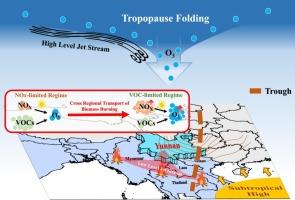Unraveling the role of stratospheric intrusion and biomass burning in springtime tropospheric ozone enhancement in Yunnan, China
IF 4.4
2区 地球科学
Q1 METEOROLOGY & ATMOSPHERIC SCIENCES
引用次数: 0
Abstract
Ozone (O3) pollution is particularly prevalent in spring and exhibits distinctive characteristics in southwestern China. Two significant natural sources contribute to O3 pollution: stratospheric intrusion (SI) and cross-border transport of biomass burning (BB) emissions from Southeast Asia. However, the roles of SI and BB in tropospheric O3 pollution in Southeast China remain insufficiently understood. This study investigated their distinct contributions during a typical SI event, using multi-source observations from AIRS satellite and surface samplers combined with the Goddard Earth Observing System coupled with chemistry (GEOS-Chem). SI and BB were identified as the key drivers of tropospheric O3 enhancement. The upper-level jet stream facilitated SI, while low-level jets, the subtropical high, and low-level troughs created favorable dynamic conditions for the cross-border transport of BB. SI primarily influenced altitudes above 500 hPa, contributing 11.3–40.0 ppb of O3. In comparison, BB transport reached as low as 850 hPa, with a positive contribution ranging from 8.5 to 11.6 ppb. Notably, O3 precursor sensitivity (OPS) rapidly shifted to a VOC-limited regime under the influence of BB. This study highlights the importance of adopting a dynamic emission reduction strategy tailored to varying OPS conditions during different O3 episodes. The findings provide valuable insights for policymakers in developing effective strategies to mitigate O3 pollution, considering the impacts of SI and BB.

平流层入侵和生物质燃烧在云南春季对流层臭氧增强中的作用
臭氧(O3)污染在春季尤为普遍,在西南地区表现出鲜明的特征。造成臭氧污染的两个重要自然来源是:平流层入侵(SI)和东南亚生物质燃烧(BB)排放的跨境运输。然而,SI和BB在中国东南部对流层O3污染中的作用尚不清楚。本研究利用AIRS卫星和地面采样器的多源观测数据,结合戈达德地球观测系统(GEOS-Chem),研究了它们在典型SI事件中的独特贡献。SI和BB是对流层O3增强的主要驱动因素。高空急流促进了SI,而低层急流、副热带高压和低空低压槽为BB的跨界输送创造了有利的动力条件。SI主要影响500 hPa以上的高度,贡献11.3-40.0 ppb的O3。相比之下,BB输运低至850 hPa,正贡献范围为8.5 ~ 11.6 ppb。值得注意的是,在BB的影响下,O3前体灵敏度(OPS)迅速转变为voc限制状态。这项研究强调了在不同的O3时段采用针对不同OPS条件的动态减排战略的重要性。考虑到SI和BB的影响,研究结果为决策者制定有效的策略来减轻O3污染提供了有价值的见解。
本文章由计算机程序翻译,如有差异,请以英文原文为准。
求助全文
约1分钟内获得全文
求助全文
来源期刊

Atmospheric Research
地学-气象与大气科学
CiteScore
9.40
自引率
10.90%
发文量
460
审稿时长
47 days
期刊介绍:
The journal publishes scientific papers (research papers, review articles, letters and notes) dealing with the part of the atmosphere where meteorological events occur. Attention is given to all processes extending from the earth surface to the tropopause, but special emphasis continues to be devoted to the physics of clouds, mesoscale meteorology and air pollution, i.e. atmospheric aerosols; microphysical processes; cloud dynamics and thermodynamics; numerical simulation, climatology, climate change and weather modification.
 求助内容:
求助内容: 应助结果提醒方式:
应助结果提醒方式:


